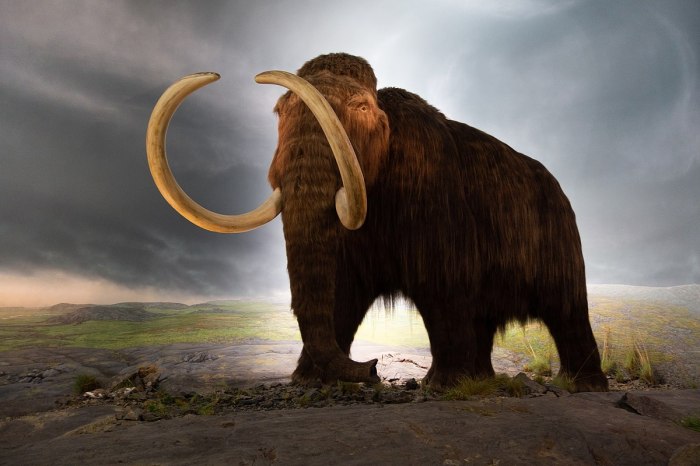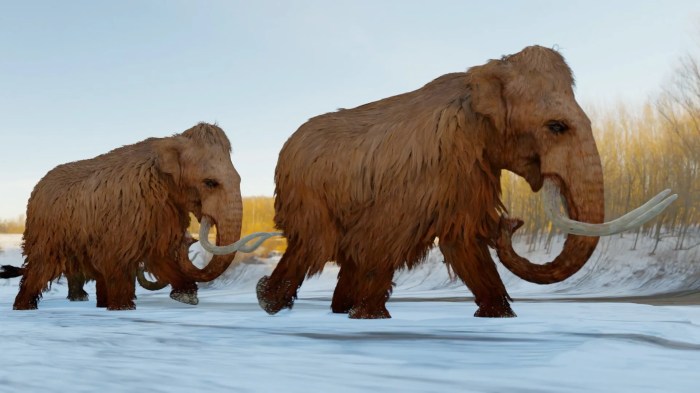The Mammoth’s Comeback: Geneticist Looks Forward To Cloning A Mammoth
The idea of bringing back the woolly mammoth, a creature that roamed the Earth during the Pleistocene epoch, is no longer confined to the realm of science fiction. Advancements in genetic engineering, particularly in the field of cloning, have ignited a renewed interest in resurrecting this extinct giant. While the challenges are formidable, the potential rewards, both scientific and ecological, are equally compelling.
Scientific Feasibility of Mammoth Cloning
The feasibility of cloning a mammoth rests on the availability of well-preserved genetic material. Fortunately, permafrost regions in Siberia and other parts of the Arctic have yielded remarkably well-preserved mammoth remains, including hair, skin, and even soft tissues. Scientists have successfully extracted and sequenced mammoth DNA from these remains, providing a blueprint for the cloning process.
The cloning process itself would involve several key steps:
- Obtaining Mammoth DNA: Scientists would need to extract and sequence mammoth DNA from well-preserved remains. The quality and completeness of the DNA are crucial for successful cloning.
- Creating a Mammoth Genome: Using advanced genetic engineering techniques, scientists would reconstruct the mammoth genome from the extracted DNA fragments. This would involve filling in gaps in the sequence and correcting errors.
- Enucleation and Nuclear Transfer: An egg cell from an Asian elephant, the closest living relative of the mammoth, would be enucleated (its nucleus removed). The mammoth’s reconstructed genome would then be inserted into the enucleated egg cell.
- Embryo Development and Implantation: The egg cell containing the mammoth genome would be stimulated to develop into an embryo. The embryo would then be implanted into a surrogate Asian elephant mother.
The success of this process is contingent on overcoming several hurdles:
- DNA Degradation: Mammoth DNA, even when extracted from well-preserved remains, is often fragmented and degraded. Scientists need to develop techniques to reconstruct a complete genome from these fragmented sequences.
- Genetic Compatibility: The genetic differences between mammoths and Asian elephants could pose challenges to embryo development and implantation.
- Surrogate Mother: Finding a suitable surrogate mother, an Asian elephant, willing to carry a mammoth embryo to term is a logistical challenge.
- Ethical Considerations: The potential impact of cloning a mammoth on biodiversity and the welfare of both the surrogate mother and the cloned mammoth raise significant ethical concerns.
Motivations Behind Mammoth Cloning
The motivations behind this ambitious project are multifaceted:
- Scientific Curiosity: The resurrection of an extinct species would be a monumental scientific achievement, providing insights into the evolution and biology of extinct animals.
- Ecological Implications: Reintroducing mammoths to the Arctic tundra could potentially have ecological benefits, such as reducing permafrost thawing, promoting biodiversity, and altering vegetation patterns.
- Potential Applications: The technology developed for mammoth cloning could be applied to other extinct species, potentially leading to the revival of other lost animals.
Ethical Considerations
While the prospect of bringing back the mammoth is captivating, it is crucial to acknowledge the ethical considerations surrounding this endeavor.
- Potential Risks to Biodiversity: The introduction of a cloned mammoth into an ecosystem could disrupt existing ecological balances, potentially harming native species and altering the food web.
- Animal Welfare: The welfare of both the surrogate mother and the cloned mammoth needs to be prioritized.
- Genetic Manipulation: The process of cloning a mammoth involves genetic manipulation, raising concerns about the potential for unintended consequences and the ethical implications of playing God.
The Science of De-Extinction
Bringing back extinct animals, like the woolly mammoth, is no longer just a science fiction fantasy. It’s a real possibility, thanks to advancements in genetics and biotechnology. This process, known as “de-extinction,” involves retrieving and analyzing ancient DNA, creating a viable embryo, and ultimately, bringing a long-lost species back to life.
Retrieving and Analyzing Mammoth DNA
Retrieving and analyzing mammoth DNA is the first crucial step in the de-extinction process. The DNA is extracted from ancient remains, such as frozen carcasses found in permafrost regions. The process involves meticulous steps to ensure the DNA is not contaminated by modern organisms. Once extracted, the DNA is analyzed to determine its completeness and quality.
- DNA Extraction: Scientists carefully extract DNA from ancient mammoth remains, typically found in permafrost regions. This process involves using specialized techniques to minimize contamination from modern organisms.
- DNA Sequencing: Once extracted, the DNA is sequenced, meaning its genetic code is determined. This provides a blueprint for the mammoth’s genome.
- DNA Analysis: The sequenced DNA is then compared to the genomes of modern elephants, revealing the differences between the two species. This information is crucial for identifying the specific genes that need to be modified to create a viable mammoth embryo.
Creating a Viable Mammoth Embryo
With the mammoth DNA sequenced and analyzed, the next step is to create a viable embryo. This involves genetic engineering techniques and the use of surrogate mothers.
- Genetic Engineering: Scientists use CRISPR-Cas9 technology to modify the genome of an Asian elephant cell, inserting mammoth DNA sequences. This process targets specific genes responsible for traits like cold adaptation, hair growth, and ear size.
- Embryo Development: The modified elephant cell is then stimulated to develop into an embryo. This embryo will contain a combination of elephant and mammoth DNA, creating a hybrid that closely resembles a mammoth.
- Surrogate Mothers: The mammoth embryo is then implanted into the womb of a surrogate Asian elephant mother. This is the most challenging part of the process, as the gestation period and the potential risks to the surrogate mother are significant considerations.
Challenges and Ethical Considerations
While the science behind de-extinction is advancing rapidly, there are significant challenges and ethical considerations that need to be addressed.
- Genetic Completeness: Retrieving complete and functional mammoth DNA from ancient remains is a major hurdle. The DNA often degrades over time, making it difficult to reconstruct the entire genome.
- Surrogate Mother Health: Using Asian elephants as surrogate mothers raises concerns about their well-being. The pregnancy and birth of a hybrid mammoth could pose risks to the surrogate mother.
- Ecological Impact: Reintroducing mammoths into the ecosystem could have unforeseen consequences. Their impact on plant life, other animals, and the overall balance of the environment needs to be carefully considered.
- Ethical Concerns: The ethical implications of bringing back extinct animals are complex. Some argue that de-extinction is a form of playing God, while others see it as an opportunity to restore biodiversity and learn from the past.
The Mammoth’s Impact on the Ecosystem
Reintroducing mammoths to the Arctic tundra could have significant implications for the ecosystem. While the prospect of bringing back these magnificent creatures is exciting, understanding their potential ecological impact is crucial. The mammoth’s role in shaping the Arctic landscape could lead to a cascading effect on the environment, influencing vegetation, soil composition, and other animal populations.
The Mammoth’s Influence on Vegetation
The mammoth’s impact on vegetation is a critical aspect of its potential ecological role. Mammoths, as megaherbivores, played a significant role in shaping the Arctic landscape during the Pleistocene epoch. Their grazing habits, coupled with their tendency to trample vegetation, led to a unique mosaic of open grasslands and scattered trees. This, in turn, influenced the composition and distribution of plant species.
The Mammoth’s Impact on Soil Composition
Mammoths’ grazing and trampling activities also had a profound impact on soil composition. Their activities helped to aerate the soil, improve drainage, and increase nutrient cycling. This could have a significant impact on the growth and distribution of plants, as well as the overall health of the ecosystem.
The Mammoth’s Influence on Other Animal Populations
The reintroduction of mammoths could also influence the populations of other animals in the Arctic ecosystem. For example, their presence could provide new food sources for predators such as wolves and bears. However, they could also compete with other herbivores for resources, potentially impacting their populations.
Potential Benefits of Mammoth Reintroduction
The reintroduction of mammoths could offer several potential benefits to the Arctic ecosystem. These benefits include:
- Increased Biodiversity: Mammoths could help to increase biodiversity by creating a more diverse and mosaic landscape, supporting a wider range of plant and animal species.
- Improved Carbon Sequestration: The increased vegetation and soil health could lead to improved carbon sequestration, helping to mitigate climate change.
- Enhanced Ecosystem Resilience: A more diverse and resilient ecosystem could be better equipped to cope with environmental changes, such as climate change.
Potential Risks of Mammoth Reintroduction, Geneticist looks forward to cloning a mammoth
However, the reintroduction of mammoths also presents potential risks, including:
- Disease Transmission: Mammoths could introduce new diseases to the Arctic ecosystem, potentially impacting other animal populations.
- Competition with Existing Species: Mammoths could compete with existing herbivores for resources, potentially impacting their populations.
- Unforeseen Ecological Consequences: The complex interactions within the Arctic ecosystem make it difficult to predict all the potential consequences of mammoth reintroduction.
The Mammoth’s Legacy
The woolly mammoth, a colossal herbivore that roamed the frozen landscapes of the Pleistocene epoch, holds a captivating place in our collective imagination. Its imposing stature, thick fur, and iconic tusks have inspired countless stories and myths, leaving an indelible mark on human history. But beyond its cultural significance, the mammoth’s legacy lies in its profound impact on prehistoric ecosystems and its intricate evolutionary journey.
Mammoth Evolution and History
Mammoths, belonging to the genus Mammuthus, emerged in Africa approximately 5 million years ago. Over millions of years, they spread across the globe, adapting to diverse environments and evolving into distinct species. The iconic woolly mammoth, Mammuthus primigenius, arose in Siberia around 400,000 years ago, characterized by its thick fur, small ears, and long, curved tusks. These adaptations helped it survive the harsh conditions of the Ice Age.
Mammoth Genetics and Evolutionary Lineage
The genetic makeup of mammoths offers fascinating insights into their evolutionary lineage. Comparing their DNA to that of modern elephants reveals a close relationship. Mammoths are closely related to Asian elephants, with their last common ancestor estimated to have lived around 6 million years ago. African elephants, however, diverged from this lineage earlier, around 8 million years ago. This genetic kinship highlights the shared ancestry of these magnificent creatures and provides valuable information about their evolutionary history.
Understanding Ancient Life through Mammoth Cloning
The prospect of cloning a mammoth holds immense scientific potential. By bringing back this extinct species, scientists could gain unprecedented insights into the biology, behavior, and adaptations of ancient life. Studying the genetic makeup of a cloned mammoth could shed light on the evolution of elephants, the impact of climate change on prehistoric ecosystems, and the mechanisms of extinction.
Geneticist looks forward to cloning a mammoth – The potential for mammoth cloning to reshape our understanding of the past and influence the future is undeniable. While the challenges are immense, the scientific and ecological implications are profound. As we navigate the ethical dilemmas and technical hurdles, one thing remains clear: the quest to bring back the mammoth is a testament to human ingenuity and our enduring fascination with the mysteries of life.
Imagine a world where mammoths roam the earth once again, thanks to the magic of genetics. While that vision might seem like something out of a sci-fi movie, scientists are getting closer to making it a reality. And speaking of big things, the HTC One E9 has been spotted with what looks to be a seriously large camera lens – htc one e9 spotted carries what looks to be large lens – maybe it’s a sign that the future of photography is about to get a whole lot more epic, just like the prospect of bringing back mammoths.
 Standi Techno News
Standi Techno News

